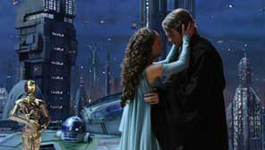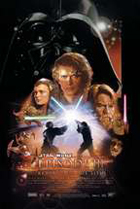Star Wars: Episode III—Revenge of the Sith
|  The brilliance of Darth Vader as a villain has always been that he started out on the good side. You can't say that of many baddies who carry with them the kind of menacing black doom inherent to Vader's raspy breath and hollow, mechanical gaze. Rather, most movie villains, in order to convey their sheer evil, are evil from the outset; no questions asked. Yet, Vader has always been more complex—and therefore interesting—because he started out good and, at some point, turned down a dark path from which he could not return. In this sense, he is decidedly Shakespearean—more Macbeth than Hannibal Lecter (the comparison to Shakespeare is an apt one particularly because highbrows are so reluctant to admit that Shakespeare's plays were the Star Wars of their day: popular and accessible). The brilliance of Darth Vader as a villain has always been that he started out on the good side. You can't say that of many baddies who carry with them the kind of menacing black doom inherent to Vader's raspy breath and hollow, mechanical gaze. Rather, most movie villains, in order to convey their sheer evil, are evil from the outset; no questions asked. Yet, Vader has always been more complex—and therefore interesting—because he started out good and, at some point, turned down a dark path from which he could not return. In this sense, he is decidedly Shakespearean—more Macbeth than Hannibal Lecter (the comparison to Shakespeare is an apt one particularly because highbrows are so reluctant to admit that Shakespeare's plays were the Star Wars of their day: popular and accessible).With this is mind, it is more clear than ever now that the Star Wars film saga, which is now complete with the release of Star Wars: Episode III—Revenge of the Sith, has always been about Darth Vader. With the exception of the droids C-3PO and R2-D2 and Obi-Wan Kenobi, he is the only character to have appeared in some form in all six films. And, writer/director George Lucas' decision to make Episodes I, II, and III was entirely about tracing Vader's descent from promising wunderkind Anakin Skywalker, the supposed "Chosen One" who was prophesized to bring balance to the Force, to lording dictator of the evil Empire. This goes a long way toward explaining why many people, both critics and fans, found the first two episodes of Lucas' prequels somewhat lacking. Simply put, they were treading water until we could get to the third episode, where the real meat lies: Anakin's transformation into Vader. This transformation, though not visualized until now, has taken on a kind of pop-cultural mythic status since the debut of Star Wars back in 1977, where Vader's sad history was first revealed. It's an easily accessible modern fable about the dangers of greed, ambition, ruthlessness, and the wanton disregard of the wisdom of our elders. The Dark Side of the Force is a catch-all stand-in for the negative flip side of everything that's positive, and Anakin-turned-Vader is the perfect fallen antihero, whose attraction lies in both his utter badness and that deeply buried nugget of goodness we know is hidden somewhere beneath all the metal and machinery. "Vader was seduced by the Dark Side of the Force," Alec Guinness' Obi-Wan Kenobi explained back in Star Wars, and the use of the word seduced—which he repeats verbatim in Return of the Jedi—is crucial in the way it humanizes the great villain, showing him to be a victim of his all-too-human flaws. It is also important that Lucas would bother to include such information in his first film, as he clearly relished planting the seed of Vader's forgotten, but not entirely lost humanity. Revenge of the Sith carries the understandably great weight of making good on visualizing a mythology that has been with us for nearly three decades, and to Lucas' credit, I can say that the film delivers. It takes Lucas a while to get there, though, as the first half hour of the film is bogged down with many of the flaws that made Attack of the Clones (2002) and, more directly, The Phantom Menace (1999) a let-down for so many. There's the overly drawn-out, narratively extraneous opening battle sequence; the overstuffed, busting-at-the-scenes mise-en-scene that evinces an "if I can, I will" mentality and makes you rue the day CGI was invented; and the slightly stilted dialogue that contains too little passion and too much exposition. Yet, about a third of the way into it, Revenge of the Sith picks up a narrative momentum, one that is fueled by decades of waiting and doesn't look back once it catches flame. We are reintroduced to Anakin (Hayden Christensen), now a full-fledged Jedi Knight under the tutelage of Obi-Wan Kenobi (Ewan McGregor). In Attack of the Clones, we saw Anakin's propensity for anger and clouded judgment to take over his soul, a dangerous tendency that is fed by the malicious Supreme Chancellor Palpatine (Ian McDiarmid), who is clearly the one will morph into the twisted Emperor who ends up holding Vader's leash. Every plot point in Revenge of the Sith is a carefully constructed fill-in for blanks we know are there. When Anakin's secret wife, the former Queen and now Senator Padme (Natalie Portman), reports to him that she is pregnant, we know exactly who is in the womb and what their future will be, which turns the film's narrative on its head (something Lucas clearly knew would happen). Revenge of the Sith is a unique film in the way its primary objective is to certify what we already know, and the pleasure it generates resides not in the surprise of what happens, but in how it happens. This is particularly true of the fiery final battle between Anakin and Obi-Wan, which takes place on a volcanic planet of spewing lava that features more bristle, intensity, and outright passion than Episodes I and II had combined. Revenge of the Sith earns its PG-13 rating (the first for a Star Wars film, although the rating didn't exist when the first trilogy was release), not so much for outright gore (although more than a few arms, legs, and heads get lopped off), but for its sheer intensity. One of the primary criticisms of the Star Wars films has been their stilted dialogue and wooden acting (it seems that Harrison Ford is the only actor who truly transcended the written page), and some of it is on parade in Revenge of the Sith. But, a curious thing happens: As the emotions get more jacked up, the performances get better. It's as if the violence of true conflict—the kind that really has narrative urgency, something the first two prequels were often lacking—has liberated Lucas the filmmaker. The entire sequence on the volcanic planet is some of his best work ever, as it soars to the kind of gut-wrenching, operatic heights he's been reaching for, but falling short of. When Padme, her face disastrous with tears, implores to Anakin in a broken voice, "You're breaking my heart," or when Obi-Wan, seeing his fallen apprentice mangled and twisted and on the verge of death by his own hand, screams in frustration and agony, "You were the Chosen One!," Revenge of the Sith achieves a grandiose emotional height, one that is infinitely satisfying for anyone who has taken even a casual interest in the unfolding saga. I was always worried that Lucas wouldn't be up to the task of taking Episode III where it needed to go, into a heart of darkness that he was clearly soft-shoeing around with the sunny go-lucky optimism of The Phantom Menace and the swaggering derring-do and syrupy romance of Attack of the Clones. All my fears have been proven wrong, as Lucas (who both wrote and directed the film) dives deep into the fiery heart of what was bound to come, swathing the final half hour in a cloak of inky darkness and finding a perfectly balanced resolution that offers the hope of things that (we know) are to come without discounting the great price that was paid to get there. Copyright ©2005 James Kendrick Thoughts? E-mail James Kendrick All images copyright ©2005 Lucasfilm Ltd. |
Overall Rating: 


 (3.5)
(3.5)


